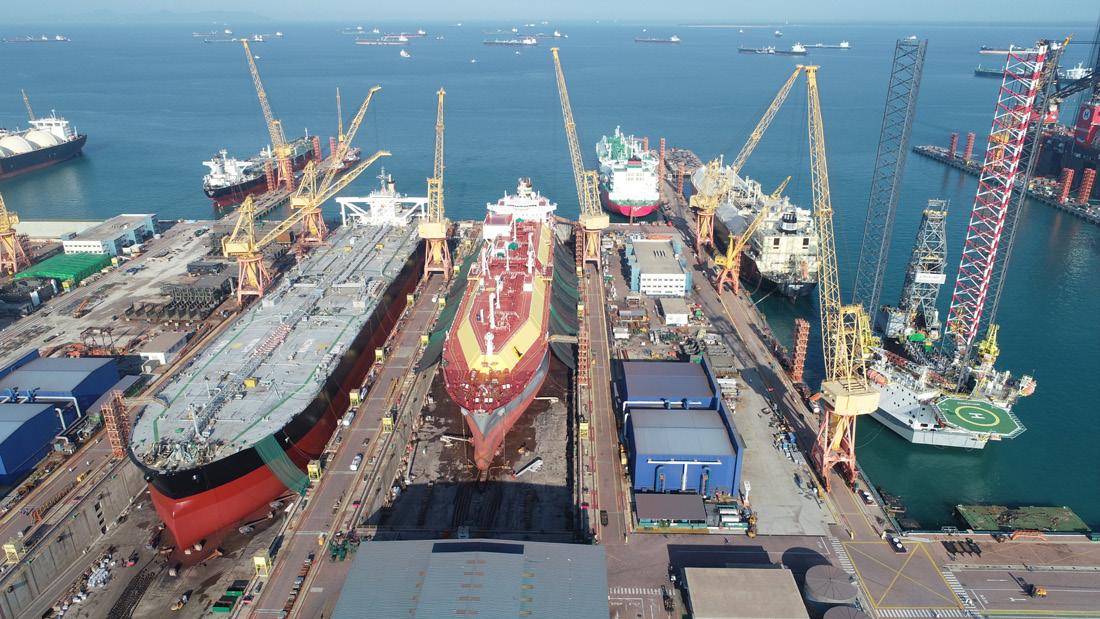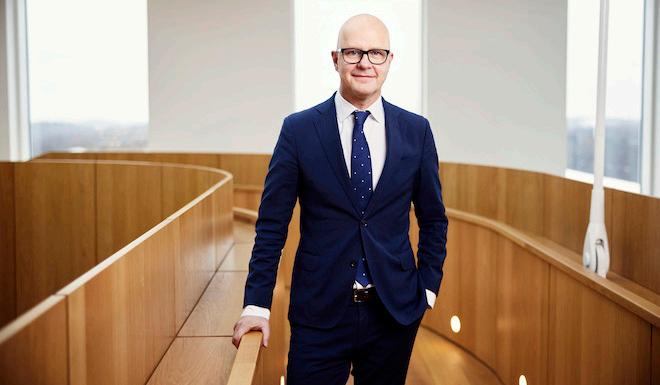
14 minute read
Paints & Coatings
Good 2021 results for Hempel
Denmark’s Hempel continued its growth trajectory in 2021, ending the year with 5.9% organic growth, following ten consecutive quarters of organic growth. Total growth was 15.1%, despite supply chain challenges across the coatings industry. The 5.9% organic growth was the highest in more than 10 years, driven by strong performance in the Marine and Infrastructure segments, and stronger than expected in the face of unprecedented raw material cost increases and shortages. EBITDA was €203m, resulting in a stable EBITDA margin of 11.4%, in line with outlook.
Advertisement
“Our performance in 2021 was very satisfactory and demonstrates that the decisive actions taken to refocus our ambitions and deliver on our strategy are paying off,” says Lars Petersson, Group President & CEO of Hempel.
Hempel made two major strategic acquisitions during 2021. In April, it acquired Wattyl, one of Australia and New Zealand’s leading manufacturers of coatings for the decorative and infrastructure segments. In September, it followed with the acquisition of UK-based Farrow & Ball, the world’s leading luxury decorative paint and wallpaper company. Together, the two companies added revenue of €162m in 2021, with expectations of an annualised full year impact in 2022 of around €275 m.
The 2022 outlook is mid to high singledigit organic revenue growth. Further, despite the unpredictable circumstances affecting raw materials, Hempel foresees a slightly increasing EBITDA margin between 11 and 12%, leading to an EBITDA of €220-240m
In February 2021, the company introduced Futureproof, a comprehensive framework and guide for embedding sustainability throughout the Hempel business, from its core operations to product development and investments. Futureproof lays out measurable Environmental, Social & Governance (ESG) goals, including CO2 reduction targets. In November, Hempel submitted its CO2 reduction targets, in line with a 1.5°C pathway, to be independently verified by the Science Based Targets initiative and expects validation in 2022.
The company also saw increased demand for its more sustainable products, such as its advanced hull coatings. These deliver fuel savings, and thereby CO2 reductions, by improving a vessel’s hydrodynamics. In 2021, Hempel’s hull coatings helped marine customers reduce CO2 emissions by 4.5m tonnes, up from 3.6m tonnes in 2020. Hempel aims to increase this to 5.5m tonnes in 2022.
“As a company, we have a responsibility to act and make a difference. In 2021, we took great steps within our operations, commercial organisation, product development and sustainability work, laying the foundation for doubling our impact by 2025. Over the next few years, we will radically advance our environmental and social performance, while also expanding our business, so we can continue to create a brighter future with more sustainable solutions and fund the philanthropic work of our owner, the Hempel Foundation,” Lars Petersson concludes.
Lars Petersson, Group President & CEO of Hempel
Latest contracts for NPM
Japan’s Nippon Paint Marine’s (NPM) nanobased anti-fouling FASTAR I has been selected for the trio of energy-efficient containerships Tsuneishi Group is building for China’s Jiangsu Ocean Shipping Co (JOSCO).
The first 1,091 teu ship in the series, Hull No SS297, is nearing completion at the shipbuilder’s facility in Zhoushan City, Zhejiang Province, China, and scheduled to join the JOSCO fleet last month (April). The second and third vessels in the series will be followed in August and September retrospectively. With an overall length of 146 m and a 23.25 m beam, each vessel in the series is based on Tsuneishi’s innovative low-resistance hull form and includes an array of energy-saving technologies. The advanced technologies include Tsuneishi’s ‘TOP-GR’ and ‘MT-FAST’ systems, of which the former optimises the number, diameter, shape and geometric distribution of propeller blades to achieve greater propulsive efficiency. Further efficiency gains are achieved with ‘MT-FAST’, which adds a wing-like device to the front of the propeller to alter water flows.
Introduced to the market early last year (2021), NPM’s fourth generation antifouling uses completely new hydrophilic and hydrophobic nano-sized silyl acrylate components to more precisely control the release of biocides.
China’s Tsuneishi group (Zhoushan) Shipbuilding, one of Japan’s Tsuneishi Shipbuilding’s overseas shipyards, is also building three similar 1,091 teu vessels for Taicang Container Lines, a subsidiary of China’s Jiangsu Port Group. These vessels, designed for the intra-regional trade, will also benefit from the FASTAR coating.
Meanwhile, the world’s largest containership by teu-carrying capacity has floated out with NPM anti-fouling and anti-corrosion systems protecting the vessel’s 400 m long hull. When delivered, the 24,000 teu class Ever Alot will be the first of four new A-Class box ships set to join the Evergreen fleet from China’s HudongZhonghua Shipyard.
NPM is supplying coating systems to all four of the 24,000 teu class sisterships Evergreen has entrusted to Hudong-Zhonghua Shipyard, in an extensive scope of supply that includes the ever-popular A-LF Sea anti-fouling system.
During the construction of the Ever Alot, A-LF Sea 150 was applied to the hull. In total, Nippon Paint Marine supplied 20 different
types of paint for myriad areas of the vessel. In addition to the anti-fouling system, the company also provided E-Marine anti-corrosion coatings for the hull, cargo holds and decks, and a NOA 60 HS system for the ship’s ballast tanks.
South Korea’s Samsung Heavy Industries (SHI) is also building three 24,000 teu vessels with A LF-Sea fouling protection; one of these vessels was delivered in 2021. Ever Arm and Ever Art will be delivered later this year. Since market introduction in 2013, more than 3,600 ships of all types have benefitted from an A-LF Sea application.
In the offshore industry, NPM is advising shipowners and shipyards converting existing oil and gas tankers into storage and production units to ensure their fuel, water and cargo tanks are sufficiently protected from corrosion. According to data from the coatings’ specialist, reduced dependence on Russian oil and gas is leading to increased demand for ships able to transport and, in particular, store gas at key locations around the world.
It was for the internal carbon steel tanks and pipework of offshore vessels and installations that NPM’s unique self-indicating NOA60HS coating was certified in 2020 by the Norwegian Technology Standards Institution as meeting the requirements of the NORSOK M-501 standard.
The anti-corrosion system incorporates a unique self-indicating technology developed to prevent incorrect application. If the coating appears transparent, then film thickness is incorrect. When it is opaque, the specified film thickness has been achieved. A number of LNG tankers are already operating with NOA coating, with NPM anticipating a rush of new orders as demand for gas ships and conversions heats up.
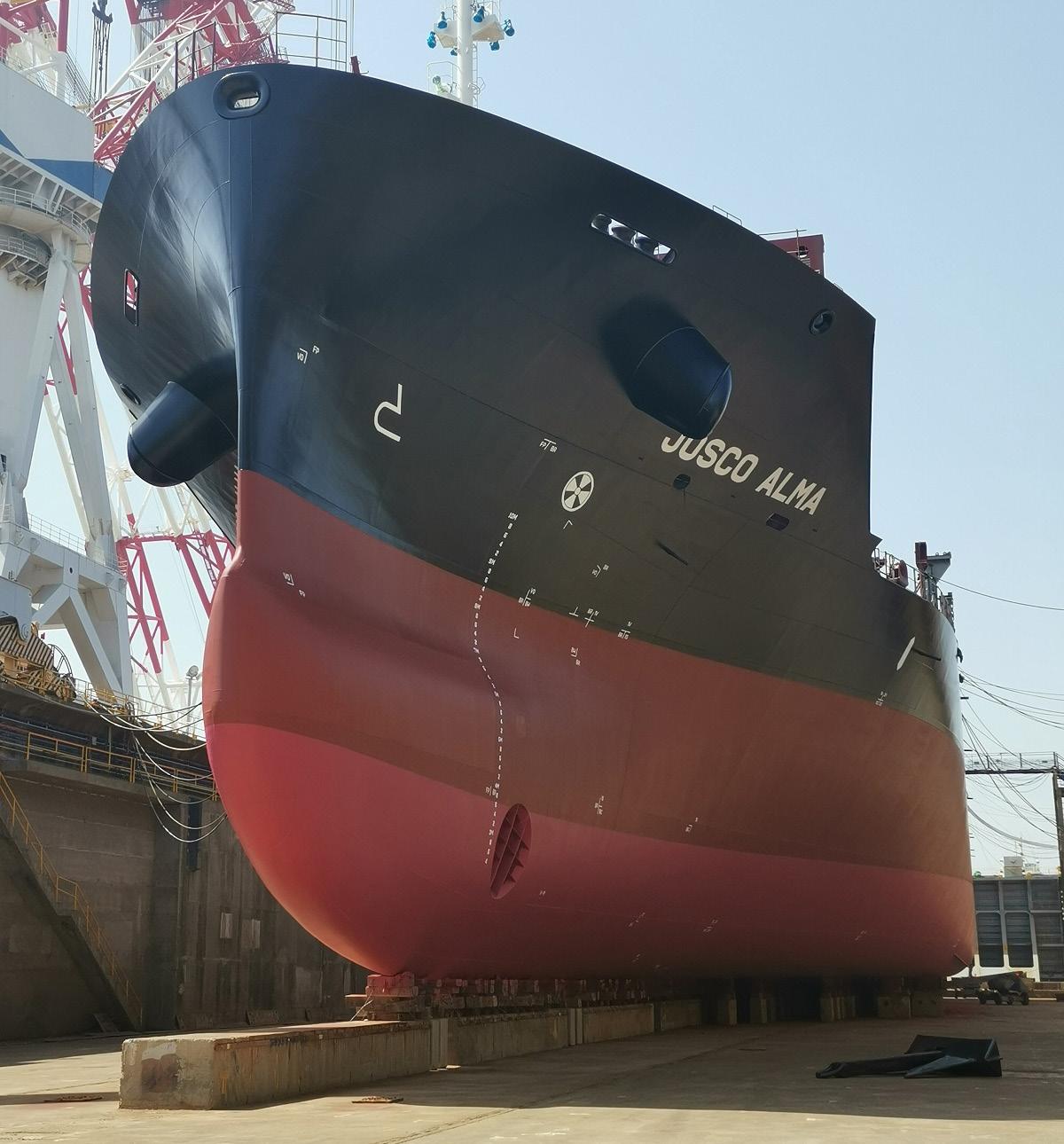
The need to have qualified coating inspectors
The Ecospeed family of coatings, which, in addition to Ecospeed include, Ecospeed Ice, Ecoshield, Ecolock and Ecolast, all part of Belgium’s Subsea Industries, are all extremely high-performance coatings. They come with a 10-year warranty (as long as a qualified paint inspector is present to monitor the application and assist the applicator or shipyard) but in fact are expected to last the life of the vessel without need for replacement.
“The reason Subsea Industries always advises shipowners to have a qualified inspector representing us as coating manufacturer present on every project is to ensure that all the specifications and quality requirements are followed precisely,” explains Andi Hermans, Production Manager at Subsea Industries and himself a qualified paint inspector.
“The coatings must be applied on a correctly prepared surface, which is crucial for a proper result, and they must be applied according to the standards and specifications of the coating itself,” Andi continues.
“Another reason it’s very important to have a knowledgeable and experienced inspector on site is so that they can guide the application,” he adds. Paint is not always given correct importance in shipyards when multiple operations are vying for priority, all under time pressure. The paint inspector will make sure that the application of the coating is given the importance it deserves.
To this end, over the years, Subsea Industries has built up a network of qualified and reliable paint inspectors who can be called at short notice to attend coating applications and ensure that these are correctly done in all cases.
According to Andi, the paint inspector’s key functions include: • Ensuring the surface has been properly prepared - roughness of at least 75µm, clean to SA 2 ½.
Checking the equipment to make sure the pump, hoses, spray gun and tip meet the requirements. Also, that tools are available in case anything comes up that needs rapid repair. • In the case of applicators new to the products, the inspector offers them brief but necessary training to familiarise them with the actions necessary for a correct application. • The inspector guides the applicators as needed with the mixing so that it is according to specs. • During the spraying, he checks that the desired wet film thickness is achieved, and that overspray is kept to a minimum and provides guidance as needed. • After the first coat is applied, the inspector checks the DFT and notes where it has to be
NPM’s nano-based anti-fouling FASTAR I has been selected for the trio of energy-efficient box ships Tsuneishi Group is building for JOSCO)
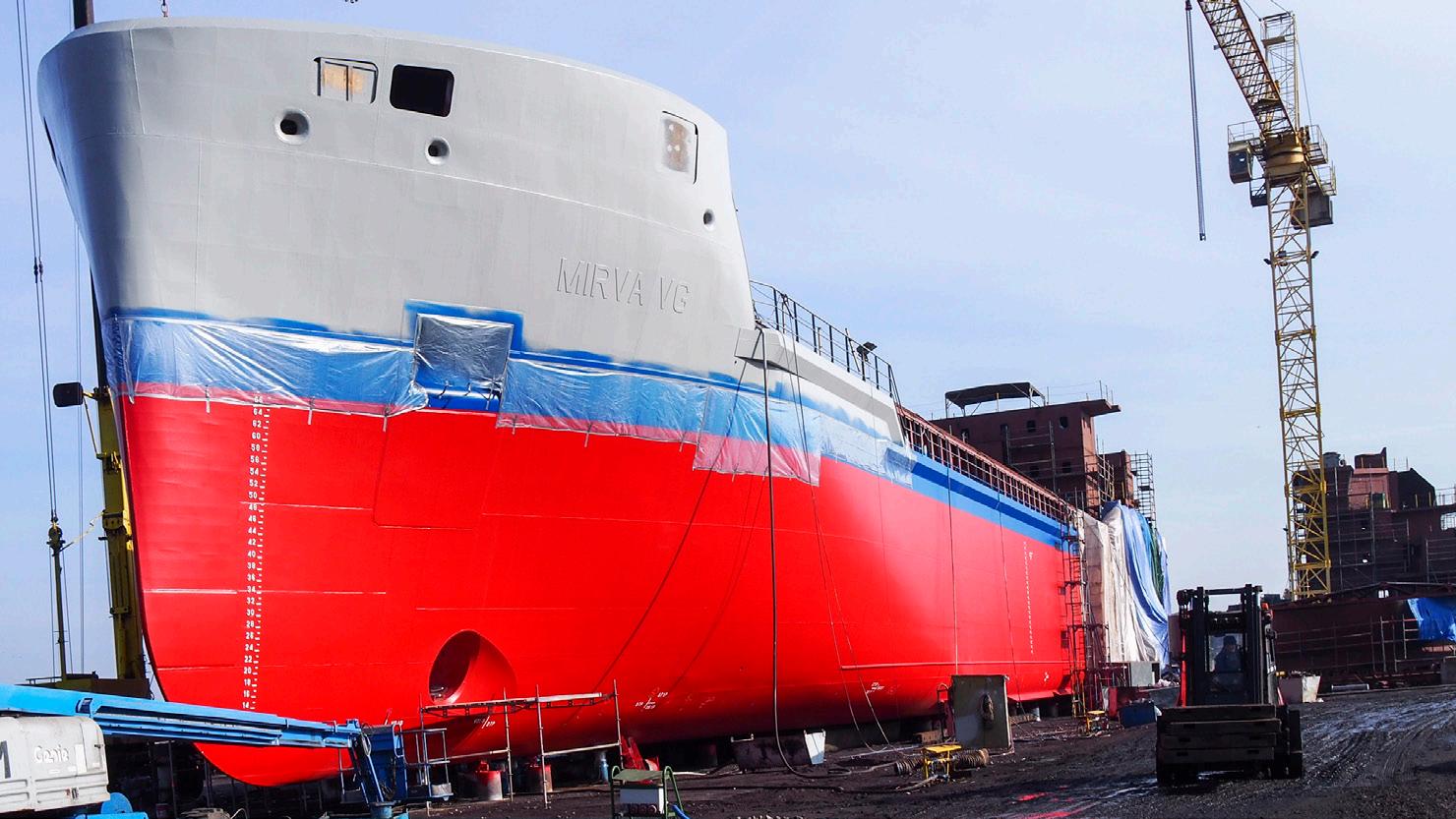
The finished hull of the Mirva VG, coated with Ecospeed
compensated for on the second coat. He also makes note of any sags that must be ground down before the second coat is applied.
“Ecospeed is a good coating for shipyard application,” Andi says. “It’s really flexible. You can apply the second coat just three hours after the first. Not many paints can do that. And you can also wait for a couple of days or even weeks to apply the second coat.” This permits great flexibility in the shipyard’s schedule.”
It is not only the inspector’s knowledge of the materials, the surfaces, equipment, and standards that are key. Andi considers that flexibility and the ability and willingness to communicate with all the different people involved in the application are vital to the success of the project. “It’s a team effort and only co-operation between all involved can obtain the premium result we are striving for on every application,” he says.
In order to get the full picture, several of the top independent paint inspectors who regularly attend applications of Ecospeed, Ecoshield and Subsea Industries’ other coatings were interviewed. These are all independent – not Subsea Industries’ employees – and their experience covers a wide range of coatings and applications. One of the interviews is included in this article. Even though this inspector has attended many full hull Ecospeed applications, the focus was on Ecoshield and Ecofix in the interviews. Ecofix is a superior, tested and proven filler. Because it uses the same basic resin as Ecoshield, the coating can be applied just one hour after the filler.
Gunnar Ackx is the Managing Director of SCICON world-wide. His impressive credentials include NACE Level III Certified Coating Inspector, SSPC Level III Certified Protective
Ship Repair | Conversions | Drydocking
by people who care about returning your vessel to service on time and in budget

detyens.com

drydock@detyens.com


Charleston, South Carolina
Coating Inspector, SSPC Certified Protective Coating Specialist and SSPC Past President (2016-2017). Based in Beernem, Belgium, Gunnar and his team cover the globe and a wide range of coating inspection and consulting projects. Gunnar was kind enough to provide detailed feedback regarding his experience with Subsea Industries coatings.
“SCICON world-wide has been inspecting Ecospeed projects since the early 2000s. We have seen that the further development of additional specialty products such as Ecoshield and Ecofix has helped to strengthen the corrosion protection of ship hull components, which are often as difficult to protect as they are critical to the ship’s operations.
“Rudders, Kort nozzles, bow thruster tunnels are all essential to the reliable operation of any vessel. At the same time they are in close proximity to the propeller blades which often causes significant cavitation challenges, on top of an already challenging corrosion protection problem.
“In our 25+ years of having inspected a wide range of ship coating projects as an independent coating inspection and consulting company, we can honestly say that we have never come across a product equal to Ecoshield. Not only does the 1000 µm of glass-platelet reinforced coating provide for excellent barrier corrosion protection, but more importantly (and that’s where we have seen many ‘similar glassflake’ coatings fail) outstanding resistance against long term cavitation and mechanical impact (ice, debris, etc…). In that respect, Ecoshield really is in a class of its own.”
With regards to application, he says, “While Ecoshield and related products may require some ‘special attention’ during application that not all shipyards are used to, they are equally easy to apply if the applicator sticks to the Application Guidelines. In fact, if you play by the rules, Ecoshield is actually much easier/ quicker to apply and much more efficient in a drydocking, because you can literally go from final blasting to final touch-up and inspection within roughly 36 hours. And 24 hours later you’re good for undocking.
“The required attendance of an Ecoshield paint inspector at each application means problems are very rare. It also results in an even better product for the owner.
“Not surprisingly, we have seen vessels coated with Ecospeed and Ecoshield, often sailing in harsh (icy) conditions, coming back into drydock multiple times over a period of 10 to 15 years without requiring any significant touch-up other than for very localised (heavy) mechanical damages. We have not seen any other hull coating system come near to this performance.
“An added advantage of Ecoshield is that it is 100% compatible with the sister hull coating product Ecospeed, so wherever on the hull cavitation damage is observed, you can very easily switch from Ecospeed to Ecoshield to provide that extra bit of cavitation protection. And similarly, Ecofix is 100% compatible with Ecoshield, so it is the perfect solution for filling up the cavitation pitting and damage first, prior to overcoating with Ecoshield.
These are the observations of one of the many independent paint inspectors Subsea Industries’ contract with to ensure that each Ecospeed, Ecoshield, Ecolock or Ecolast application is carried out to the correct specifications and standards which will ensure that they perform at optimum for the life of the vessel. Subsea Industries considers the paint inspectors to be an essential element in the delivery and they frequently receive glowing feedback from their customers. They are an essential part of the team.
Chinese fleet contract for APC
USA-based Advanced Polymer Coatings (APC) is gearing up production after signing a new deal with Chinese shipowner Shandong Shipping, to supply a fleet of 50,000 dwt medium range tankers.
APC makes the MarineLINE protective cargo tank coating, and the new deal follows the successful completion of an earlier contract with Shandong for APC to apply MarineLINE to eight new 50,000 dwt MR product/chemical tankers to be chartered to Shell for its ‘Shell Project Solar’ programme. That deal saw APC supply MarineLINE to the New Times Shipbuilding, at the Xingang Port in Jingjiang City and completed in November 2021.
APC President David Keehan says the new agreement will commence in July 2022 again supplying the New Times Shipyard. The latest vessels will also be chartered by Shell as part of Shell Project Solar. “To win repeat business from Shandong and Shell on this high-profile project is testament to the hard work and effort of all involved,” he said. “Each ship has 20 cargo tanks, including two slop tanks, which require MarineLINE coating, along with application inspection, and full heat curing services. So, this will be an extensive job for our team working with the specialists at New Times Shipbuilding with whom we have developed a close working relationship.”
Mr. Keehan said MarineLINE won a competitive tender to secure the work with Shandong due to having a range of benefits. “The low absorption characteristics and highly glossy surface of MarineLINE allow operators to reduce overall tank cleaning times, which in turn reduces fuel consumption and GHG emissions associated with hot water production (see notes to editors),” he said. “This, combined with the cargo versatility and flexibility that MarineLINE offers over its competitors, is giving us a real edge. What we mean by versatility is ease of cleaning between different cargoes, meaning operators can switch grades more frequently, with significantly less risk of cross contamination. These are key advantages in the chemical tanker market, where vessels can be expected to transport a wide variety of chemicals. Less tank cleaning directly equates to less tank cleaning slops, and enhanced crew safety based on maintaining rest hours and reducing the need for multiple confined space entries into the cargo tank.”
APC now actively supports washing water analysis (WWA) which allows vessels to continuously optimise their tank cleaning procedures. WWA is also being used by a growing number of commercial interests to replace the wall wash inspection, and this is helping to reduce over-cleaning in linings with the lowest absorption characteristics.
APC recently announced one of its most successful years of trading with maritime sales growing by 40% in 2021. APC reported it now accounts for more than 12% of the global cargo tank coating market and is specified on more than 700 ships, with 56 ships coated equating to over 750,000 m2 of MarineLINE applied in 2021. Exports are underpinning APC’s growth with key markets including China, the Gulf, Croatia, and Turkey.
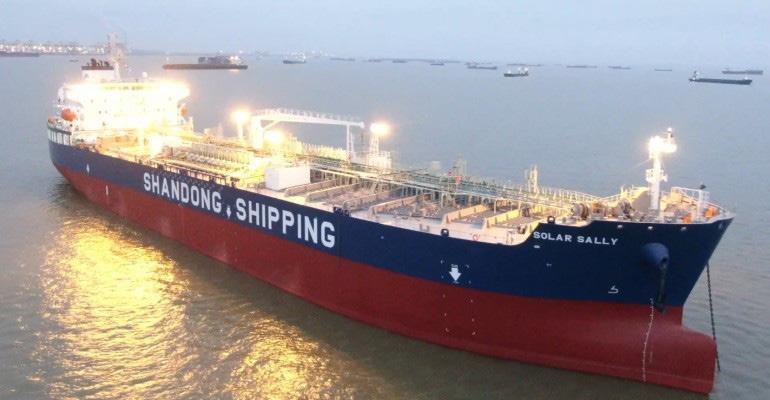
One of the Shadong Shipping fleet
SORJ



